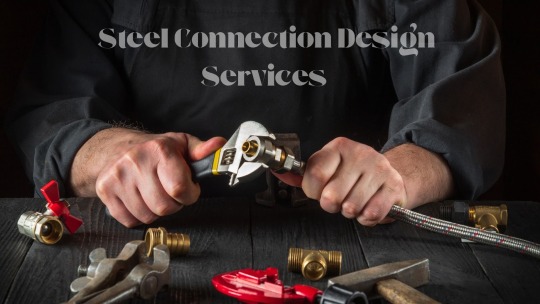#SteelConnectionDesign
Explore tagged Tumblr posts
Text
Steel Connection Design Services: Ensuring Strength and Stability in Every Joint
In structural engineering, a steel structure's integrity depends on its members and how they're connected. Whether it's a skyscraper, bridge, or industrial facility, steel connections are the unseen forces that hold everything together. This is where Steel Connection Design Services become essential, ensuring that each joint, weld, and bolt contributes to a structure’s overall strength, safety, and performance.
From the smallest gusset plate to complex moment frames, proper connection design is critical to structural resilience. These connections must be engineered to transfer loads accurately, resist movement, and comply with codes and safety standards. Professional connection design plays a key role in balancing safety, constructability, and cost-efficiency.

What Are Steel Connection Design Services?
Steel connection design services involve the engineering analysis and detailing of how steel structural elements, such as beams, columns, and braces, are joined together. The goal is to ensure these connections can safely transfer axial forces, bending moments, shear, and torsional loads between members under various conditions, including seismic and wind loads.
These services typically include
Design of bolted and welded connections
Shear, moment, and axial connections
Base plate and anchor bolt design
Connections, calculations, and modelling
3D detailing and shop drawings
Connection design specialists use advanced software and engineering methods to make sure each joint in a steel framework works well under pressure.
Types of Steel Connections
There is no universal solution for connection design. Depending on the structure's function, location, and load requirements, different connection types are used:
1. Bolted Connections
These are the most common in modern steel construction due to ease of installation and removal. Bolted connections include:
Shear connections (simple)
Moment connections (rigid)
Seated and end-plate connections
2. Welded Connections
These offer high strength and rigidity and are often used where load paths are complex or visual appeal is crucial. Although welded connections are precise, they require skilled labor and stringent quality checks.
3. Hybrid Connections
Some structures benefit from a combination of bolting and welding, taking advantage of both types' strengths while minimizing their limitations.
Importance of Steel Connection Design
1. Structural Safety
Poorly designed connections are a common point of failure in buildings during extreme events like earthquakes or heavy wind loads. Precision in connection design ensures that load paths are predictable and secure.
2. Code Compliance
Connection designs must meet international and regional codes such as AISC (American Institute of Steel Construction), Eurocode, IS 800 (India), and others. Experienced engineers ensure every detail is code-compliant and certifiable.
3. Constructability
Well-designed connections simplify fabrication and erection. Engineers consider accessibility, fabrication methods, and construction sequences to minimize field complications and reduce labor costs.
4. Cost Efficiency
Connection optimization can significantly reduce the quantity of steel, welding, or bolts needed, ultimately lowering project costs without compromising safety or performance.
Tools and Technologies Used in Connection Design
Today’s connection design relies on a range of advanced software tools and technologies. Some commonly used platforms include
STAAD.Pro and ETABS for structural analysis
IDEA StatiCa, RAM Connection, and Tekla Structures for steel connection design
AutoCAD, Revit, and Advance Steel connection design services are used for detailed drafting and 3D modeling.
These tools allow engineers to simulate real-world load scenarios, check for stress distribution, and produce detailed fabrication-ready drawings.
Industries that Rely on Steel Connection Design
Steel connection design services are crucial across multiple sectors:
Commercial Construction: Office buildings, malls, and hotels rely on moment-resisting frames and column-beam connections.
Industrial Facilities: Warehouses, factories, and plants require robust bolted/welded connections to support machinery and equipment.
Infrastructure Projects: Bridges, flyovers, towers, and stadiums require advanced connections that can bear dynamic loads.
Energy Sector: Oil & gas rigs, transmission towers, and solar panel structures depend on reliable steel joint design.
Why Hire Professional Steel Connection Designers?
Hiring experts in connection design offers numerous benefits:
Accuracy & Safety: Licensed structural engineers bring the expertise needed for safe and code-compliant joints.
Time Efficiency: With optimized detailing and analysis, professionals streamline the design-to-construction pipeline.
Customization: Each project receives tailored solutions based on its structural layout, load paths, and construction methods.
Coordination with Fabricators: A good connection design minimizes fabrication errors, delays, and on-site issues by aligning closely with shop drawing requirements.
What to Expect from a Connection Design Partner
An ideal connection design service should provide the following offerings:
Preliminary connection concepts based on architectural intent
Load-based calculation reports and design sheets
Fabricator-friendly shop and erection drawings
On-call support during fabrication or construction
Revisions and optimisations based on feedback
A collaborative approach ensures the connections are not only structurally sound but also practical to implement in real-world conditions.
Conclusion:
Discuss the importance of structural integrity in ensuring safety and longevity in connection designs.
Explore how design collaboration between engineers and architects can lead to more innovative solutions.
Explain how to handle real-world implementation issues that might come up while building.
Outline the relevant engineering standards that guide connection design and ensure compliance with regulations.
Consider sustainability factors in connection design, including material choices and energy efficiency.
While the public often overlooks connections, engineers and builders view them as crucial components of a structure. Properly engineered steel connections enhance a structure's strength, durability, and performance across its lifecycle. Whether you're constructing a high-rise building or an industrial facility, reliable Steel Connection Design Services ensure peace of mind and long-term value.
#SteelConnectionDesign#StructuralEngineering#ConnectionDesignServices#BoltedConnections#WeldedConnections
0 notes